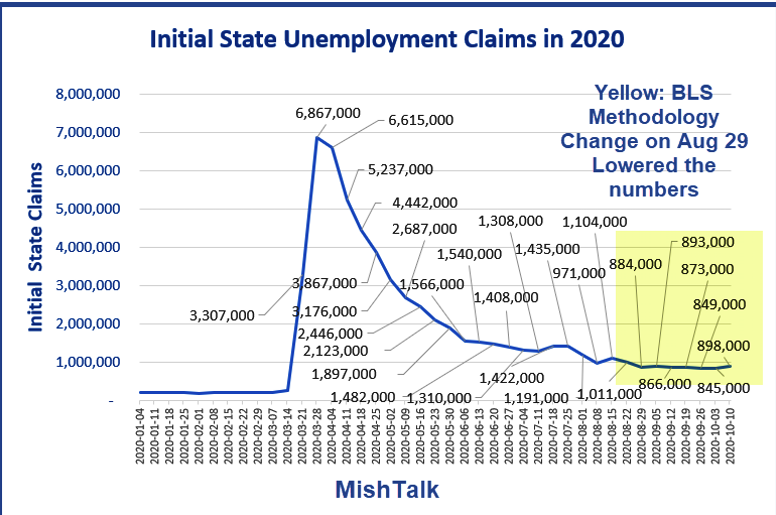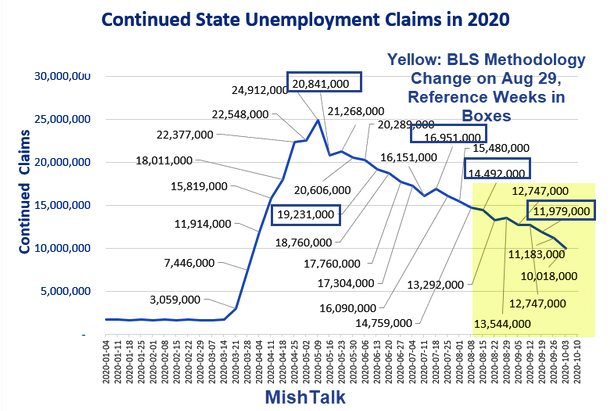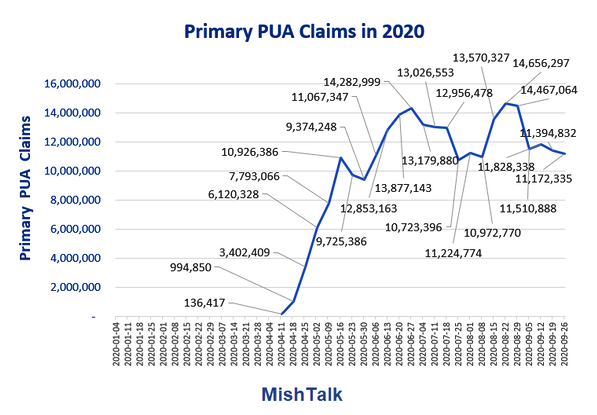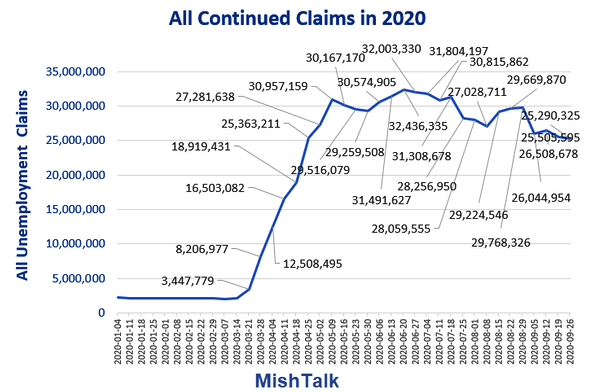
Unemployment claims unexpectedly rose to the highest level in 8 weeks.
Initials State Unemployment Claims
Seasonally-adjusted initial claims for the week ending Oct. 10 rose to 898,000 from 845,000 according to the Department of Labor.
That's the highest total since 1,011,000 on Aug. 22.
The BLS changed its methodology for counting initial claims effective Aug. 29. The change artificially lowered the counts for that week.
Since the BLS did not revise back, the weeks starting Aug. 29 are distorted vs the weeks prior.
Continued State Unemployment Claims

Continued state unemployment claims lag initial claims by a week.
Continued claims are more important than initial claims. It is continued claims that determine the official unemployment rate.
The rate is set by survey on the week that contains the 13th of the month, the weeks in boxes.
Suspect Improvement
Seasonally-adjusted continued claims fell from 11,183,000 last week to 10,018,00 this week.
However, continued claims are distorted by three factors.
Continued Claims Distortions
- BLS Methodology Change on Aug.29.
- California is so messed up it froze reporting.
- People in some states have expired all of their state benefits and thus fell off the rolls.
California Fraud
Bloomberg Econoday has this interesting blurb last week regarding California.
California is now offline when it comes to claims data as it scrambles to limit unemployment fraud. With the weekly estimate for the US's largest state now frozen at a prior level of more than 260,000, forecasters see total initial claims easing slightly but not substantially to 819,000 in the October 3 week.
California is still offline. I assure you fraud goes well beyond California.
Primary PUA Claims in 2020

Primary Pandemic Unemployment Assistance
Unlike state claims, PUA applies to people working part-time, gig workers, and self-employed workers who do not qualify regular state unemployment programs.
Over 11 million people receive PUA. This is where most of the fraud is hidden.
I suspect most of it is not fraud, but no one knows the real numbers due to the loosy-goosy nature of the program.
In terms of determining unemployment, I suspect that at least 2 million of those 11 million are genuinely unemployed.
All Continued Claims in 2020

Like PUA Claims, All Continued Claims are not seasonally adjusted.
They lag continued claims by a week and initial claims by 2 weeks.
Over 25 million people receive some assistance. That number, minus fraud and mistakes should feed the U6 (alternate unemployment rate).
Estimating the Unemployment Rate
The latest jobs report came out on Oct. 2 as discussed in Job Recovery Slows and Headwinds Mount for October
The BLS says the number of unemployed is 12,580,000.
The Unemployment Rate = #unemployed / Labor Force.
UR = 12,580,000 / 160,143,000 = 7.9%
But continued claims for the reference week were 11,979,000.
PUA claims are over 11 million. Some number of them (2,000,000 to 4,000,000) are genuinely unemployed.
Even if we assume only 1 million of those 11 million are unemployed, the BLS unemployment rate is too low.
Take my low-end guess of an additional 2 million, the unemployment rate is (11,979,000 + 2,000,000) / 160,143,000 = 8.7% vs the BLS claim of 7.9%.
If we assume PUA fraud or errors at 4 million (a generous to the BLS assumption) we can make the following calculation:
The U6 Unemployment rate would be (25,290,325 - 4,000,000) / 160,143,000 = 13.3% not the reported 12.8%.
